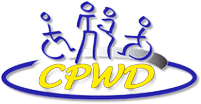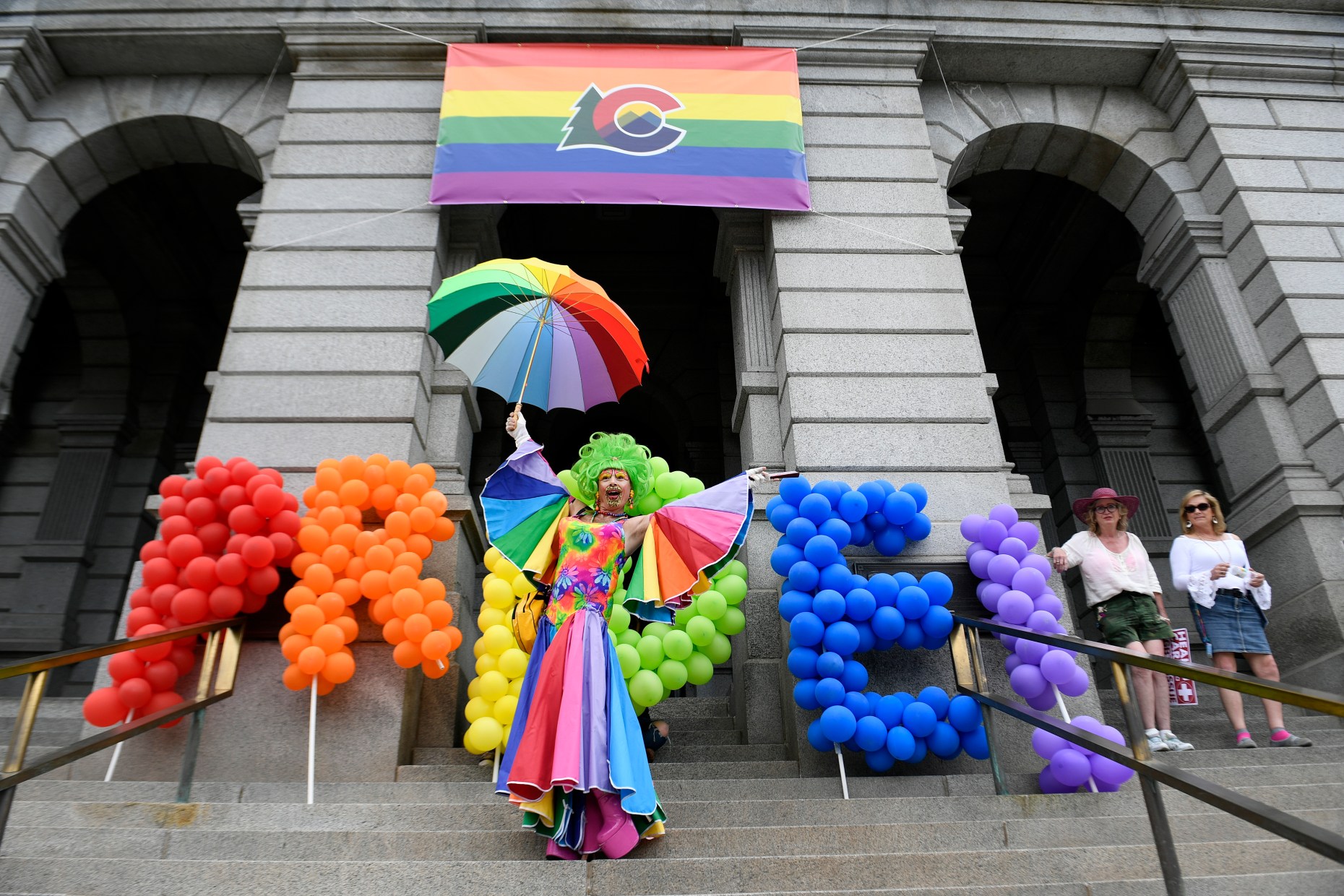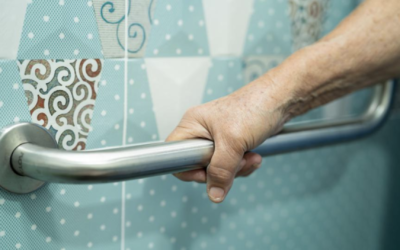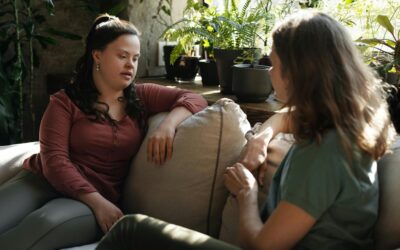Image description: A person dressed in Pride colors in front of a series of colored balloons spelling out PRIDE
Celebrating Pride with Everyone: Disability Inclusion in the LGBTQ+ Community
Pride Month, celebrated every June, is a vibrant time for the LGBTQ+ community to come together, commemorate progress made towards equality, and raise awareness of ongoing challenges. It’s a celebration of diversity, self-expression, and the fight for LGBTQ+ rights. However, within the LGBTQ+ community itself, there’s another vital conversation happening: disability inclusion.
Similar to those identifying as LGBTQ+, people with disabilities are often underrepresented in society. Both communities have historically faced discrimination and marginalization, and their experiences often overlap and intersect. This Pride Month, let’s celebrate the beautiful tapestry of the LGBTQ+ community and acknowledge the importance of disability inclusion.
As a clarification, while they overlap, Disability Pride (celebrated in July), is similar but different from LGBTQ+ Pride.
Disability Pride is a movement that celebrates the unique identities and contributions of people with disabilities. It’s about rejecting shame and stigma, and instead embracing disability as a natural part of human diversity. Disability Pride goes beyond simply raising awareness. It’s about challenging societal perceptions and advocating for a world where people with disabilities have equal opportunities and are valued members of their communities. Disability Pride is a celebration of resilience, strength, and accomplishment. People with disabilities overcome significant challenges every day, and this movement recognizes those triumphs. It’s about taking pride in one’s identity and advocating for a more inclusive future.

Image description: A person using a wheelchair during a Pride march
Similar to LGBTQ+ Pride, Disability Pride often takes the form of parades, festivals, and community events. These celebrations offer a platform for people to connect, share experiences, and raise awareness. They are a powerful display of pride, self-acceptance, and the demand for a more accessible world.
A Look Back: The History of the Pride Movement
The roots of Pride can be traced back to the Stonewall Uprising in 1969. On June 28th, a police raid on the Stonewall Inn, a gay bar in New York City, sparked six days of protests and riots. This pivotal event ignited a firestorm of activism, leading to the formation of the Gay Liberation Front and the Gay Activists Alliance, two of the earliest LGBTQ+ rights organizations in the United States.
Pride marches soon followed. The first Christopher Street Liberation Day March, held in New York City in 1970 to commemorate the anniversary of Stonewall, marked a turning point. Similar marches were held in Los Angeles and Chicago that same year. Over the years, Pride celebrations have spread across the globe, becoming a powerful symbol of LGBTQ+ visibility and resistance.
The fight for LGBTQ+ rights has seen significant progress. Landmark victories include the decriminalization of homosexuality in all 50 states, the repeal of “Don’t Ask, Don’t Tell,” and the legalization of same-sex marriage nationwide. However, the fight for full equality continues, with issues like discrimination in housing, employment, and healthcare still facing the LGBTQ+ community.
Double Marginalization: The Intersection of LGBTQ+ and Disability
Members of the LGBTQ+ community with disabilities can face a unique set of challenges. They may experience discrimination based on both their sexual orientation or gender identity and their disability. For example, LGBTQ+ individuals with physical disabilities might encounter inaccessible Pride events or struggle to find restrooms that cater to their needs. LGBTQ+ individuals with hidden disabilities like autism or dyslexia might face social anxieties or sensory overload in crowded Pride celebrations.
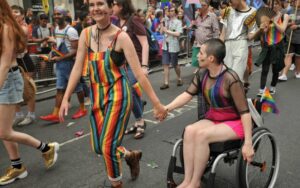
Image description: A Pride person walking with another Pride person using a wheelchair
Building Bridges for a More Inclusive Pride
Here are some ways to make Pride Month more inclusive for people with disabilities:
- Accessibility: Prioritize accessible event venues with ramps, elevators, and wide doorways. Ensure there are designated accessible seating areas at events and parades. Provide clear signage with braille or audio descriptions for those with visual impairments.
- Sensory Awareness: Offer designated quiet spaces or sensory-calming areas at events for people who might be overwhelmed by loud music or crowds. Consider providing noise-cancelling headphones or fidget toys.
- Communication: Offer information about events in multiple formats, including large print, audio recordings, and transcripts. Utilize sign language interpreters for presentations and announcements.
- Transportation: Consider offering accessible transportation options for attendees who have difficulty using public transportation or walking long distances.
- Respectful Language: Avoid making assumptions about someone’s disability based on their appearance. Use person-first language when talking about disabilities (e.g., “a person with a disability” instead of “disabled”).
- Empowerment: Actively seek out and amplify the voices of LGBTQ+ individuals with disabilities. Celebrate their achievements and contributions to the community.
Denver Pride: Celebrating Diversity with Everyone in Mind
Denver, Colorado, boasts a vibrant LGBTQ+ community with a long history of activism. Denver PrideFest, held this year in Civic Center Park on June 22-23, is a major event attracting thousands of attendees. The Denver PrideFest organization prioritizes accessibility and inclusivity:
- Accessible Features: The event website provides detailed information on accessible parking, restrooms, and seating areas.
- Sensory Considerations: Sensory-calming areas are available for attendees who might be overwhelmed by loud music or crowds.
- Sign Language Interpreters: Sign language interpretation is provided for all main stage presentations and announcements.
Moving Forward: A United Front for Equality
By actively promoting disability inclusion within the LGBTQ+ community, we can create a more welcoming and celebratory space for everyone. Here are some ways to stay involved:
- Support Disability Rights Organizations: Advocate for organizations working towards full inclusion of LGBTQ+ individuals with disabilities.
- Educate Yourself & Others: Learn more about the challenges faced by LGBTQ+ individuals with disabilities. Promote awareness by having conversations with friends, family, and colleagues.
- Volunteer Your Time: Volunteer
Additionally, here are some resources for those interested in learning more:
- The Trevor Project: https://www.thetrevorproject.org/ (Provides crisis intervention and suicide prevention services to LGBTQ+ youth)
- The National Center for Lesbian Rights: https://www.nclrights.org/ (Advocates for the legal rights of LGBTQ+ women, girls, and non-binary individuals)
- American Association of People with Disabilities: https://www.aapd.com/ (Champions the political, economic, and social rights of people with disabilities of all ages)
Let’s celebrate Pride Month with a spirit that embraces the full spectrum of human experience!
